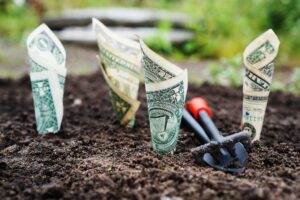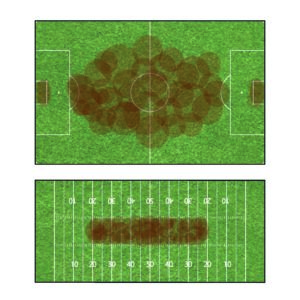 MGG’s Ryan Anderson shares lawn care strategies to protect both the environment and your budget.
MGG’s Ryan Anderson shares lawn care strategies to protect both the environment and your budget.
You don’t have to break the bank to grow playable, resilient and chemical-free natural grass athletic fields. MGG’s Technical Assistance Program (TAP) team has identified multiple practices that will both save the environment and your pockets.
Prioritize your parks and greenspaces
Most fields do not need to look like professional golf courses to satisfy community expectations. We ask our TAP park district, school and/or municipality partners to group their fields from highest priority to lowest priority. Next, we recommend reducing or eliminating mowing, fertilization, weed control, aeration, overseeding and irrigation on the lower priority fields. The partner can easily shift these labor and product cost savings toward the management of their higher prioritized fields.
 A manager can perform this prioritization exercise for just one athletic field. The red in the diagrams to the right visualize the most trafficked sections of both soccer and football fields. These sections will more likely experience compacted soil and stressed turfgrass. A manager can save money and grow healthy grass by focusing aeration, overseeding and fertilization on these red areas and sparingly employing these practices in the non-highlighted sections.
A manager can perform this prioritization exercise for just one athletic field. The red in the diagrams to the right visualize the most trafficked sections of both soccer and football fields. These sections will more likely experience compacted soil and stressed turfgrass. A manager can save money and grow healthy grass by focusing aeration, overseeding and fertilization on these red areas and sparingly employing these practices in the non-highlighted sections.
Select low-input and competitive grass mixes
MGG has witnessed the most progress recently in low-input, wear tolerant and competitive grass mixes. Investing in these mixes will reduce or even eliminate future pesticide, fertilizer and water needs. Most TAP projects have recommended a rhizomatous tall fescue mix or microclover mix.
Improve the Soil
Billions of bacteria, fungi, nematodes and invertebrates reside in every cubic foot of soil. These organisms break down organic matter, cycle nutrients, balance pH, inhibit plant pathogens and so much more. Healthy soil microbiomes will eliminate the long-term need for fertilizers, pesticides and water. To achieve a healthy soil ecosystem, you should test the soil to determine nutrient, pH and organic matter imbalances, recycle grass clippings, shred and mulch leaves, topdress fields with compost and regularly aerate high-traffic fields.
Stress fall lawn care
The best time for spring lawn care, is fall lawn care. Grass expends more energy on root-growth in the fall season. Roots contain the hormones and nutrients that will jump-start your fields next growing season. Aerate, overseed and fertilize your athletic fields to grow the deepest roots this fall.
Engage your community
 You will likely not achieve optimal turfgrass performance overnight if transitioning your fields from synthetic chemicals. TAP provides extensive community engagement support to our clients to manage expectations and, ultimately, costs during the transition period. This support includes press releases, interpretive signage, educational events, social media posts and more.
You will likely not achieve optimal turfgrass performance overnight if transitioning your fields from synthetic chemicals. TAP provides extensive community engagement support to our clients to manage expectations and, ultimately, costs during the transition period. This support includes press releases, interpretive signage, educational events, social media posts and more.
Do you want to implement more sustainable landscaping practices on your greenspaces this year? Please reach out to myself at randerson@ipminsitute.org or attend MGG’s October 26th sustainable landscaping workshops in River Forest, IL. Registration to either the morning or afternoon sessions is $30 each at bit.ly/SustainableLandscaping22.
